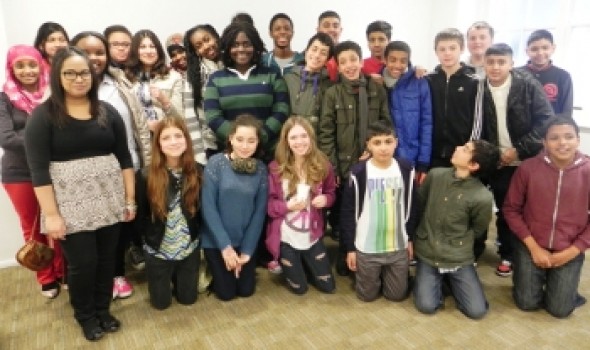Making a better future for multicultural London
Making a better future for multicultural London

Michelle Johansen of Bishopsgate Institute discovers a positive attitude towards migration and multiculturalism among Langdon School pupils in East London.
According to data from the 2011 census roughly 20% of Londoners have English as a second language, a figure that rises to 40% in the culturally diverse borough of Newham where Langdon School is situated.
Pupils on the roll at Langdon come from a range of minority ethnic backgrounds. This informs the planning of some lessons as history teacher Andy Brown explained: ‘Newham borough has been home to migrants for generations, first from rural Britain and Ireland, then the Caribbean and South Asia and now increasingly from Latin America, Africa and Eastern Europe. Our school is proud to have pupils from families from every part of the world. Our families here speak over fifty different languages. This year we've developed a Multicultural London unit studying four of the migrant groups which have come to East London.’ The four migrant groups included French Huguenots in the seventeenth century and Russian Jews in the nineteenth century.
For many Langdon pupils (as for thousands of Londoners today) the notion of travelling long distances in search of security or a better way of life has personal resonance. Their first-hand understanding of the sense of dislocation and loss that can accompany long-distance migration perhaps explained their sensitive and thoughtful responses to the unit topic. At the same time, their lived experience of diversity has engendered a broadly positive view of multiculturalism as a concept. When asked to explain the meaning of multicultural, they focus on notions of interchange, negotiation and enrichment: ‘different cultures and races living together peacefully’; ‘ideas can transfer from one culture to another’; ‘each culture contributes ideas, business, accents and intellect’; and so on.
Such upbeat interpretations have not always been the norm, as the pupils discovered when they visited Bishopsgate Institute to take part in a multicultural London archives learning workshop. ‘It was good to explore the archive materials and see people’s views on multiculturalism, whether positive or negative, and society’s reaction to it.’ Langdon Pupil
Bishopsgate Institute is a library, archive and cultural institution located close to Liverpool Street Station. We hold specialist historic collections relating to the history of London with a particular emphasis on political and radical movements since the nineteenth century. We have an institutional mission to share our archives with a range of audiences. We also like to provide opportunities for others to interpret our collections in fresh and original ways, which was why we invited pupils from Langdon School to co-curate and design a temporary exhibition on the Multicultural London unit they were studying in school. Their exhibition would be informed by their classroom learning, together with their findings in the archives at a workshop session. During the workshop the pupils examined original materials from several of our collections, including campaigning pamphlets from the Freedom Press collection, press photographs from the Morning Star photographic archive, government publications from the London collection and political ephemera from the Bernie Grant archive.
Most of the items they looked at were from the 1970s and 1980s, a troubled yet critical period in the history of race relations in Britain. The materials represented a range of opinions, both for and against multiculturalism and the pupils had the opportunity to discover for themselves what one boy termed ‘the racism of the olden days and the hard life of the people’ by examining items such as Under Heavy Manners (1977), a pamphlet which accused officers in the metropolitan police of using violence or intimidation towards minority ethnic groups, especially when arrests were made ‘behind closed doors’ in people’s flats or houses. Other items provided affirmative milestones on the route towards an arguably more tolerant and diverse Britain today.
The pupils selected two Morning Star photographs as evidence of this. One photograph showed Ronald Hope, the first non-white police officer in Britain to attain the rank of Inspector in 1979 and the other was of the Notting Hill Carnival in 1980, providing – as a pupil expressed it – ‘a positive interpretation of multicultural London because it has different people from different cultures celebrating together.’ Another pupil was struck by the fact that so many groups and organisations campaigned for a more diverse and accepting society: ‘some of these sources talk about making a better future for multi-cultural London and that is what our project is about – making a better future.’ This viewpoint was largely shared among the Langdon pupils. Their final exhibition text and materials offered an overwhelmingly positive message of unity and tolerance in the city – both now and for the future.
Photo by: Learning Collection, Bishopsgate Institute, 2013. Langdon students celebrate their achievements together following the workshops at Bishopsgate Institute.’ Schools & Community


